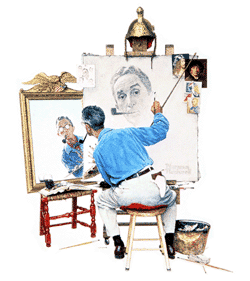Big touring exhibition celebrates Rockwell`s Americana
 To enter the San Diego Museum of Art, at the moment, is to leave America behind. Your destination: a place called Americana. It`s a thoroughly charming land, even when things turn a touch melancholy - which isn`t often. Americana even resembles America in many ways, except the sordid and ugly aspects of life in the actual United States aren`t evident. Norman Rockwell didn`t exactly invent the land of Americana, but he is its painter laureate.
To enter the San Diego Museum of Art, at the moment, is to leave America behind. Your destination: a place called Americana. It`s a thoroughly charming land, even when things turn a touch melancholy - which isn`t often. Americana even resembles America in many ways, except the sordid and ugly aspects of life in the actual United States aren`t evident. Norman Rockwell didn`t exactly invent the land of Americana, but he is its painter laureate. No American this side of Mark Twain captures the joys, struggles and pranks of childhood quite like Rockwell, whether it be boys on the run as they flee the swimming hole with the sign that says "No Swimming," or the young girl playing adult dress-up before the mirror. No one else captures the look of the small-town doctor or country lawyer with such precision.
Late-19th-century novelist William Dean Howells, a close friend of Mark Twain`s, championed literature that depicted the smiling aspects of life. Rockwell represented the fulfillment of this idea in painting, though with more sugarcoating than Howells might have wanted. Critics and curators have long classified him as the cornball storyteller among artists. Now, as the century that gave us Rockwell becomes history, some members of the art world`s intelligentsia have done an about-face. He should be seen, they argue, as a major unrecognized painter of democratic life.
One of the best art critics at work today, Dave Hickey, wrote an eloquent essay on Rockwell in 1996. A year later, art historian Karal Ann Marling published a book on the artist for a series that features volumes on the likes of more accepted masters Edward Hopper and John Singer Sargent.
Meanwhile, a big nationally touring exhibition was in the making, "Norman Rockwell: Pictures for the American People," co-organized by Atlanta`s High Museum of Art and the Norman Rockwell Museum. It debuted in November and is now on view at the San Diego Museum of Art. The last stop in this march toward canonization is New York, where Rockwell`s paintings will line the spiraling ramps of the Guggenheim Museum.
This, clearly, is Rockwell`s art historical moment. But do the paintings themselves persuade that he should rise like a phoenix from the ashes of his lowbrow status? Well, he deserves to rise, but not quite that grandly. Let`s just say he deserves more recognition, but he isn`t an unsung great. The claims being made for him in some of 14 essays for the big book that accompanies the exhibition need to be downsized.
"Charming" is the adjective that fits him best. He is, to be more precise, a virtuoso of the charming anecdote. His version of a Sunday outing in the family car, "Coming and Going" (1947), compresses the event beautifully. He crops the car so we see the windows as frames for the family. Rockwell captures the energy and anticipation in the faces of adults, children and dog alike; then, their droopy demeanors on the return trip.
He manages the effect again and again. His "Boy in a Dining Car" (1946) is trying to figure out how much to tip his waiter, who looks on with amusement. In "Roadblock" (1949), one of the drivers of a large truck tries to coax their obstacle, a small dog, from the middle of an alley; the event has attracted a richly varied crowd that makes for an eventful gallery of characters.
All these smile-producing scenes are among the show`s 70 paintings. And all are among the impressive grid of 322 Saturday Evening Post covers that stretch across a long expanse of museum wall. It`s a shrine to his prolific output and a huge reminder that reproductions, not the canvases, were likely uppermost in Rockwell`s mind in the studio. The paintings aren`t much more engaging in the canvas than in printed form, except for the obvious virtue of increased size.
It was through magazine covers and other illustrations that he became the people`s artist, the Will Rogers of American painting. He was, at least in the mass media, a "happy storyteller" with a "folksy exterior." The phrases belong to his son, Peter, who also writes in the exhibition`s companion book that his father was a "sophisticated technician with a knowledgeable interest in the history of Western painting."
Looking at these paintings, how can anyone doubt this last claim? No one structures a genre picture as well as Rockwell did without a fine understanding of the history of storytelling images.
He would work a little of that sophistication and art history into his work, from time to time, as in "Triple Self-Portrait" (1960). Within the picture, there are tiny versions of self-portraits by Durer, Rembrandt and Van Gogh, as well as a cubist picture by Picasso, tacked to the canvas in progress. The working Rockwell has his back to us. The canvas on the easel has no color, but will soon - it is a drawing of the artist`s face. To his left is a mirror, with yet another likeness of Rockwell. The title misleads, too, since another tiny drawing of Rockwell is tacked to the work in self-portrait on the easel. My kind of realism, he reminds us in his "aw shucks" way, is as filled with artifice as a Cubist painting.
In the 1960s, Rockwell seemed to tire of being seen as only the pleasing painter of the people. He turned to social criticism, creating the lifeless "Golden Rule" (1961), with the expected words superimposed on a crowd of faces that dutifully includes all ages and races. "The Problem We All Live With" (1964) is more convincing, with its portrait in profile of a seemingly fearless little girl, Ruby Bridges, walking between U.S. marshals as they head for the New Orleans elementary school she integrated.
These forays into commentary are a footnote in the exhibition and his career. He seems like an uncomfortable tourist in the real America, in all its varied and troubled dimensions. Rockwell and his art were far more at home in the land of Americana, sweetly embodied by the small New England town of Stockbridge, Mass., as he pictured it in his panoramic 1967 picture "Home for Christmas" (not on view). It`s where he lived out his last years (he died in 1978) and it`s where the monument to his art, the Norman Rockwell Museum, resides.
"Norman Rockwell: Pictures for the American People," through Dec. 31, San Diego Museum of Art, the Prado, Balboa Park, $5-$12, Mondays-Fridays; $6-$14, Saturdays and Sundays; advance tickets recommended (619) 232-7931 or (619) 220-TIXS.
(c) Copley News Service
advertisement

Related Articles
Author: Robert L. Pincus
Archives
Van Gogh and Gauguin together again
Harry`s Here
Memoir recalls courtship in Dachau
Mr. Smith goes to Hollywood
Moises Kaufman
And now ... the rest of the story
Finally, a time for Grandma
Homing in on Homer`s distinctly American flair
Gidget is back, and she`s original
Ego tours: rock and roles
Springtime for Brooks
The cradle does rock
Behind their music
Fluid approach to architecture is hallmark of modernist
New American plays mirror transitional theme
More Articles







